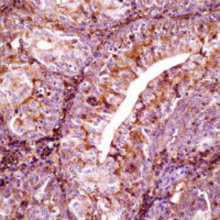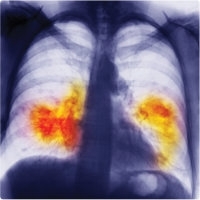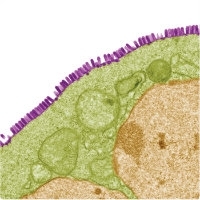Microshorts
Issue: Viruses and Cancer - 2013
18 February 2013 article

Viruses and cancer
The development of cancer is a multistage process and it is clear that infectious agents either directly cause or are strongly associated with up to 17% of malignancies in the developed world. Viruses play a significant role by directly causing aberrant cell growth through the action of transforming genes, the establishment of chronic inflammatory processes or virus-induced immunosuppression that predisposes to oncogenesis, or the provision of a critical first ‘hit’ in the multistage oncogenic process.
Vaccination against certain viruses has proven beyond any question that certain cancers are preventable, as exemplified by the success of vaccination against hepatitis B, preventing hepatocellular carcinoma, and human papillomavirus in the case of cervical carcinoma. In the veterinary arena, vaccination of chickens against Marek’s disease virus (an oncogenic herpesvirus) has proven efficacy in preventing lymphomas. Nonetheless, there is
much to be done.
In many cases where there is a strong association of a particular virus with a tumour, the function and significance of virus-encoded gene products expressed in transformed cells is poorly understood. In addition, little is known of the environmental co-factors or host genetics that may predispose to virus-associated cancers, and the existence of a ‘hit-and-run’ mechanism of virus-induced oncogenesis has few proponents and is deserving of further scrutiny.
From a different perspective, in recent years considerable effort has been placed in the development of viruses as potential treatments against human cancers, based on either the delivery of ‘suicide’ genes, the development of genetically manipulated viruses that selectively replicate in transformed cells or the development of viruses with selective tropism for tumour cells. The development of oncolytic viruses shows considerable promise as evidenced by the increasing number of clinical trials currently in progress.
Stacey Efstathiou Editor-in-Chief, JGV
Figure: Cancerous cells from the bladder of a water buffalo. Dr Sante Roperto, Università di Napoli Federico II, Italy
Fighting lung cancer with viruses

Viruses could help control certain fast-growing lung cancer cells, according to researchers at Johns Hopkins University. In recent years, Seneca Valley virus – which selectively targets cancerous cells but not normal somatic cells – has shown promise as a potential anti-cancer treatment. However, some types of aggressive ‘small cell lung cancer’ have previously been thought to be resistant to infection. By manipulating the viral genome to produce a green fluorescent ‘reporter’ protein, the researchers found that a small sub-population of these cancer cells is in fact highly susceptible to the virus. The researchers also confirmed that only cancerous cells were targeted: when they infected tumour-bearing mice with the virus, it did not replicate in normal tissues. The ability to infect only a subset of tumour cells could prove useful in anti-cancer treatments. For example, viruses could be used to deliver toxins to specific cancer-affected regions of the body.
J Gen Virol doi:10.1099/vir.0.046011-0
Adam Kucharski Imperial College, London
Figure: Chest X-ray showing lung cancer. Photodisc / Thinkstock

Papillomavirus infection-linked cancer in fern-grazing buffalo
Bovine papillomavirus may infect over 90% of buffaloes grazing on ferns in Turkey. Ingesting ferns is thought to trigger papillomavirus BPV-2 activation, leading to cancerous growth, perhaps through suppression of the buffalo immune response. In addition, BPV-2 has been clinically detected in cancerous bladder tissue specimens from buffaloes. BPV-2 infection promotes induction of the E5 oncoprotein, promoting cancerous cell growth. Fluorescently imaging these proteins on tumour samples by microscopy showed the platelet-derived growth factor (PDGF-β) receptor interacting with E5 and BPV-2, again providing evidence of BPV-2 involvement in virus-induced cancers. The association between fern ingestion and papillomavirus infection has also been seen in humans who have developed throat cancer in Brazil. It is economically important in farming to understand the strategies that BPV-2 papillomavirus uses to cause cancer in cattle and buffalo. Discovering more about the 189 types of papillomavirus and their ability to infect other animal species could lead to potential preventative strategies and treatments.
J Gen Virol doi:10.1099/vir.0.047662-0
Rebecca Way University of Aberdeen
Figure: Water buffalo. Stockbyte / Thinkstock
Battling cancer with viruses

The use of viruses specifically to kill cancer cells is an increasingly emerging area of research due to the impaired ability of many cancer cells to clear virus infection. Research outcomes have been so successful that one virus has already been approved for clinical use in China. Researchers at the University of North Carolina discuss the potential of a widely studied virus, Vesicular stomatitis virus (VSV), to be used as an anti-cancer agent in a recent review. VSV causes infections in animals, including horses, but is generally asymptomatic in humans. So far, VSV has been genetically modified to reduce toxicity and increase selectivity of killing cancer cells. One such VSV strain has been developed to encode interferon, which enhances the immune system to improve oncoselectivity. It has shown so much promise that a phase 1 clinical trial is now underway. With some fine tuning of oncolytic properties, VSV may soon be used alone or as an adjunct to current therapies to fight cancer.
J Gen Virol doi:10.1099/vir.0.046672-0
Naomi Osborne Thermo Fisher Scientific
Figure: VSV particles (purple) budding from a cell (green). Steve Gschmeissner/Science Photo Library
